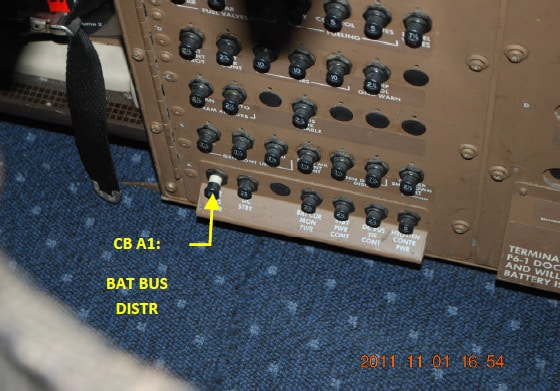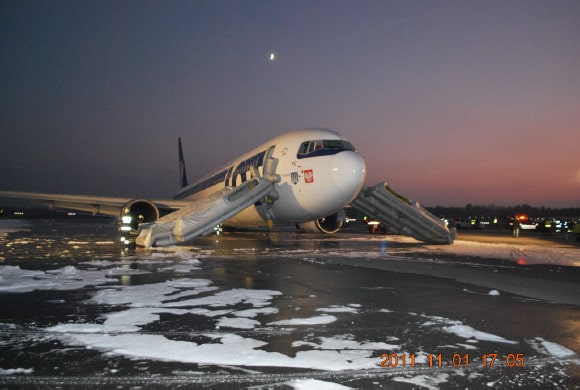Fly Like an Eagle, Land Like a Crow
Edit: This was written directly after the accident. I wrote an updated two-part piece after the final report came out, which you can find here: https://fearoflanding.com/accidents/accident-reports/land-like-a-crow-part-1/.
On the 1st of November in 2011, LOT airlines flight LO16 was flying into Warsaw-Okęcie when the main landing gear and nose gear failed to deploy. They landed on the fuselage on runway 33.

The Ministerstwo Transportu, Budownictwa I Gospodarki Morskiej (Ministry of Transport, Construction and Maritime Economy) have released a PDF of the accident description in English.
All times are in UTC.
04:19:51 Flight LO16, a Boeing B-767-300 takes off from Newark, New Jersey with 221 passengers, 8 cabin crew and 2 flight crew.
The flight crew consisted of two experienced Polish pilots. The captain has flown for LOT Polish Airlines since 1981 and at the time of the incident had 13,307 hours experience on the Boeing-767 (15,980 in total). The First Officer had 9,431 hours flight time, with 1,981 of those on the B-767. The aircraft was 25 years old and in good condition. It was inspected at Newark by the local maintenance crew and no faults were found.
04:19:55 The flight crew retracts the landing gear
04:21:07 The flight crew retracts the flaps
04:22:11 First indication of fault: low pressure in the central hydraulic system.
04:22:14 Hydraulic fluid quantity in the central hydraulic system drops dramatically.
A hydraulic fluid leak was discovered in the central hydraulic system (installation “C”).
A passenger commented on AVherald that in the cabin they heard “a strange noise like an electric or hydraulic motor triggered several times but failing to end its action.”
The loss of hydraulic pressure appeared to be an isolated fault and the flight crew and Operations crew agreed to continue the flight to Warsaw (EPWA), where they would extend the landing gear using the alternate landing gear extension system.
04:36:28 Cruise altitude FL310
The media questioned the decision to carry on, but a single failure does not necessarily require an immediate landing. The aircraft was safe to fly. There are back-up systems for the landing gear. Continuing to their destination gives them a planned daylight landing at their home airport rather than an emergency landing at Newark in the dark.
09:18:08 Cruise altitude FL370
The flight to Poland was uneventful. The METAR at Warsaw confirmed that there was good visibility with scattered low cloud, a slight tail wind over the runway, and no significant weather.
11:44:17 Flight LO16 begins descent to land.
During the approach to Warsaw-Okęcie the flight crew used the alternate system to extend the landing gear.
The landing gear did not extend.
12:18 Flight LO16 abandon approach and divert to holding zone. The alternate landing gear extension system continues to fail to lower the landing gear.
12:25 The flight crew declare an emergency.
12:45 Combat aircraft from a local Air Force base are sent to visually check the landing gear.
The flight crew are hoping that it is a computer glitch. Maybe the wheels are in fact all down and the failure is in the reporting.
13:06 The pilots of the combat aircraft confirm that the landing gear and nose gear are not visible, that is, they are still in the retracted position.
The crew attempt again to manually extend the landing gear “in the gravitational way”: that is, release the doors so that the wheels fall out of the plane and into position.
The landing gear does not extend.
As the fuel levels are dropping and all attempts to extend the landing gear have failed, the crew decide to execute an emergency landing with the landing gear retracted: landing on the belly of the plane.
13:39 The plane lands safely at Warsaw-Okęcie on runway 33. The passengers are evacuated immediately and are clear of the plane within 90 seconds. There are no injuries.
Passengers told the press that the landing was so smooth, they thought that at the last moment, the gear must have extended.
Investigators reached the aerodrome 15-20 minutes after the evacuation of the passengers and crew.
There they found a damaged hydrawlic hose in the right main landing gear which caused the failure of the central hydraulic system.
But they also found something more disturbing:

In the cockpit, on P6 panel, the circuit breaker C829 BAT BUS DISTR (on A1 position) was in the position „Off”, while the circuit breaker C4248 LANDING GEAR – ALTN EXT MOTOR (on F6 position) was in the position „On”.
Circuit breaker C829 BAT BUS DISTR includes the alternate landing gear extension system. There was no record of the breaker being off and the Flight Data Recorder and other airplane systems did not indicate that the breaker was off.
The captain has stated that they checked all circuit breakers twice and did not find any that had popped out.
It is possible that the circuit breaker popped out during the landing as a result of the alternate gear extender being left on. However, if the circuit breaker was out and they missed it, it puts an entirely new light on the response of the flight crew to the situation. I’ll be very interested to read the final report.
Meanwhile, Captain Tadeusz Wrona, with close to 20 years experience on the 767, is being hailed as a national hero for this excellent landing. Wrona means crow in Polish, leading to this new proverb:
Lataj jak orzeł, ląduj jak Wrona.
Fly like an eagle, land like a Crow.









The final report is available via https://aviation-safety.net/database/record.php?id=20111101-0
“The SP-LPC was lifted with harnesses and airbags originally designed for B737. The lifting operation started at 16:07 hrs and ended at 18:03 hrs on November 2, 2011.
When the airplane was lifted, a ground power source was connected and in the presence of SCAAI member, the Operator’s staff and the prosecutor’s office representative the C829 circuit breaker was set in ON position (pushed) and the alternate landing gear extension system was activated. The landing gear was extended and locked. The airplane was towed to the Operator’s technical base.”
The reports concludes that the circuit breaker was inadvertently popped; it states that Boeing had started installing guards for these breakers in production shortly after this plane came off the line, but that the retrofit was only available as a paid upgrade that the airline had not installed (and neither had they installed the upgraded hose connection that would have prevented the hydraulic leak in the first place).
The plane was sold for scrap in 2013.
I should have updated this at the time! I did a two-part post on this after the final report came out, part one is here: https://fearoflanding.com/accidents/accident-reports/land-like-a-crow-part-1/
Thanks for the comment, I’m adding this to the main post now as well.